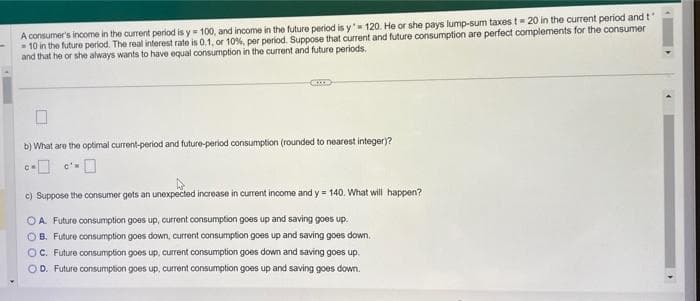A consumer's income in the current period is y= 100, and income in the future period is y'= 120. He or she pays lump-sum taxes! 10 in the future period. The real interest rate is 0.1, or 10%, per period. Suppose that current and future consumption are perfect complements for the consumer and that he or she always wants to have equal consumption in the current and future periods. b) What are the optimal current-period and future-period consumption (rounded to nearest integer)? C c) Suppose the consumer gets an unexpected increase in current income and y = 140. What will happen? OA Future consumption goes up, current consumption goes up and saving goes up.
A consumer's income in the current period is y= 100, and income in the future period is y'= 120. He or she pays lump-sum taxes! 10 in the future period. The real interest rate is 0.1, or 10%, per period. Suppose that current and future consumption are perfect complements for the consumer and that he or she always wants to have equal consumption in the current and future periods. b) What are the optimal current-period and future-period consumption (rounded to nearest integer)? C c) Suppose the consumer gets an unexpected increase in current income and y = 140. What will happen? OA Future consumption goes up, current consumption goes up and saving goes up.
Chapter17: Capital And Time
Section: Chapter Questions
Problem 17.2P
Related questions
Question
4

Transcribed Image Text:A consumer's income in the current period is y 100, and income in the future period is y'= 120. He or she pays lump-sum taxes t = 20 in the current period and t
10 in the future period. The real interest rate is 0.1, or 10%, per period. Suppose that current and future consumption are perfect complements for the consumer
and that he or she always wants to have equal consumption in the current and future periods.
b) What are the optimal current-period and future-period consumption (rounded to nearest integer)?
CN
c) Suppose the consumer gets an unexpected increase in current income and y = 140. What will happen?
OA. Future consumption goes up, current consumption goes up and saving goes up.
OB. Future consumption goes down, current consumption goes up and saving goes down.
OC. Future consumption goes up, current consumption goes down and saving goes up.
OD. Future consumption goes up, current consumption goes up and saving goes down.
Expert Solution
This question has been solved!
Explore an expertly crafted, step-by-step solution for a thorough understanding of key concepts.
Step by step
Solved in 3 steps with 2 images

Knowledge Booster
Learn more about
Need a deep-dive on the concept behind this application? Look no further. Learn more about this topic, economics and related others by exploring similar questions and additional content below.Recommended textbooks for you


Economics: Private and Public Choice (MindTap Cou…
Economics
ISBN:
9781305506725
Author:
James D. Gwartney, Richard L. Stroup, Russell S. Sobel, David A. Macpherson
Publisher:
Cengage Learning

Macroeconomics: Private and Public Choice (MindTa…
Economics
ISBN:
9781305506756
Author:
James D. Gwartney, Richard L. Stroup, Russell S. Sobel, David A. Macpherson
Publisher:
Cengage Learning


Economics: Private and Public Choice (MindTap Cou…
Economics
ISBN:
9781305506725
Author:
James D. Gwartney, Richard L. Stroup, Russell S. Sobel, David A. Macpherson
Publisher:
Cengage Learning

Macroeconomics: Private and Public Choice (MindTa…
Economics
ISBN:
9781305506756
Author:
James D. Gwartney, Richard L. Stroup, Russell S. Sobel, David A. Macpherson
Publisher:
Cengage Learning